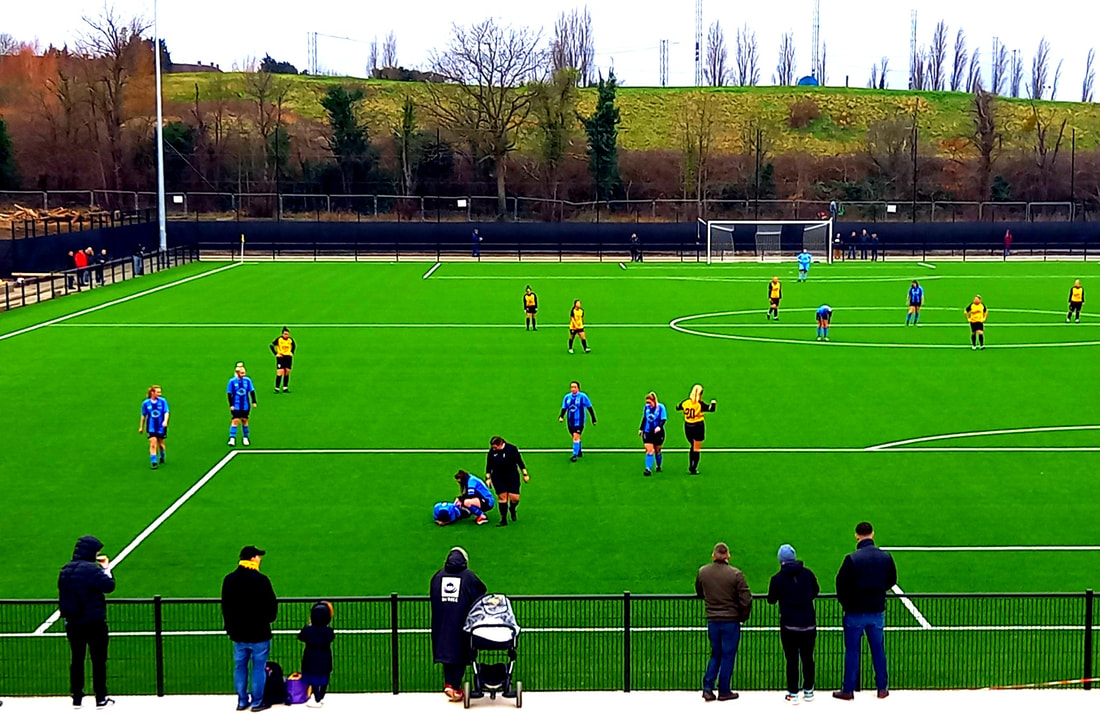
Football's Coming Home ...
Cray Wanderers FC and the story of their 164-year journey from Star Lane to Flamingo Park
The purchase and redevelopment of Flamingo Park on the A20 Sidcup bypass has a central purpose of providing a new home and headquarters for London's oldest football club Cray Wanderers. The official opening of the ground, playing the first competitive match there on 4th February 2024 is a massive feat and the end of a long and winding road for Gary Hillman the chairman and the club's co-directors and investors. The club's many supporters will be well aware of the perseverance that is needed when such a large project needs to be financed and planned to completion.
The Flamingo Park project is broader than simply football. It offers regeneration of a large area of land in the Crays that is being under-used as an asset to the community. The full project will deliver new jobs and a range of new upgraded sporting and social amenities. We can accordingly characterise Flamingo Park as one of several enterprising initiatives to boost the social-economic face of the Crays. Other examples can be found currently at Allied Bakeries in Cray Avenue and at Coca Cola in Footscray. Both of these business sites are former grounds where Cray Wanderers played pre-war (at Fordcroft and at Twysdens Meadow) before the land was earmarked for commercial development.
In this article we will look back at each of the previous grounds where Cray Wanderers have played and then we will offer some current social-economic context for the upcoming move to Flamingo Park where building work has already started.
Cray Wanderers FC and the story of their 164-year journey from Star Lane to Flamingo Park
The purchase and redevelopment of Flamingo Park on the A20 Sidcup bypass has a central purpose of providing a new home and headquarters for London's oldest football club Cray Wanderers. The official opening of the ground, playing the first competitive match there on 4th February 2024 is a massive feat and the end of a long and winding road for Gary Hillman the chairman and the club's co-directors and investors. The club's many supporters will be well aware of the perseverance that is needed when such a large project needs to be financed and planned to completion.
The Flamingo Park project is broader than simply football. It offers regeneration of a large area of land in the Crays that is being under-used as an asset to the community. The full project will deliver new jobs and a range of new upgraded sporting and social amenities. We can accordingly characterise Flamingo Park as one of several enterprising initiatives to boost the social-economic face of the Crays. Other examples can be found currently at Allied Bakeries in Cray Avenue and at Coca Cola in Footscray. Both of these business sites are former grounds where Cray Wanderers played pre-war (at Fordcroft and at Twysdens Meadow) before the land was earmarked for commercial development.
In this article we will look back at each of the previous grounds where Cray Wanderers have played and then we will offer some current social-economic context for the upcoming move to Flamingo Park where building work has already started.
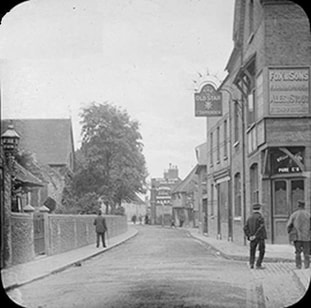
Star Lane (1860 to ?? circa 1881?)
The foundation date of the present-day Cray Wanderers football club is taken to be 1860 and the first football pitch was near Star Lane in St Mary Cray. The proximity to the railway line and splendid railway viaduct provides a substantial clue because the football grew from informal recreation by the visiting navvies and the local villagers when the railway line was being constructed to cross the Cray valley. Thereafter the London, Chatham & Dover railway ran through the Crays and connected the area to the London metropolis and to the Kent coast - a vital boost to the economy of the Crays. It appears that the football pitch was in a field owned by the Tyrer family who at times in the late 19th century were coal, corn and brick merchants and also owners of the Blue Anchor public house. The cemetery in Star Lane was built in 1881 and although the football pitch at 'Tyrersfield' may still have been in use at that time we know that by the late 1880s the football pitch was instead at the Recreation Ground in St Mary Cray.
Photo: An old print of Star Lane with the Old Star public house in foreground on the right.
The foundation date of the present-day Cray Wanderers football club is taken to be 1860 and the first football pitch was near Star Lane in St Mary Cray. The proximity to the railway line and splendid railway viaduct provides a substantial clue because the football grew from informal recreation by the visiting navvies and the local villagers when the railway line was being constructed to cross the Cray valley. Thereafter the London, Chatham & Dover railway ran through the Crays and connected the area to the London metropolis and to the Kent coast - a vital boost to the economy of the Crays. It appears that the football pitch was in a field owned by the Tyrer family who at times in the late 19th century were coal, corn and brick merchants and also owners of the Blue Anchor public house. The cemetery in Star Lane was built in 1881 and although the football pitch at 'Tyrersfield' may still have been in use at that time we know that by the late 1880s the football pitch was instead at the Recreation Ground in St Mary Cray.
Photo: An old print of Star Lane with the Old Star public house in foreground on the right.
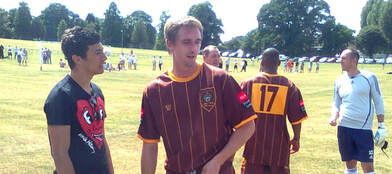
St Mary Cray Recreation Ground (Derry Downs)1880s and 1890s until 1898
Cray Wanderers played here during part of the 1880s and on till 1898. This included the period when the club played its first ever official county competitive football starting with the Kent Junior Cup in 1889 and the Kent League in 1894. As best we can ascertain the pitch was located at the Derry Downs end of the open area that is known nowadays as the Park Road recreation ground. The pitch had a slope and also a small wooden stand for spectators. in 2010 to mark the club's 150th anniversary Cray Wanderers staged a friendly match versus Crockenhill at St Mary Cray Rec. The new pitch was located at at the flat Crowhurst Way end of the park. We think that the old pitch stood on the rising ground to the left of the photo in which Cray players George Porter and John Guest can be seen at the Crockenhill match in July 2010. Note that the Cray team were wearing a special replica kit from the old Victorian days when the club colours were 'chocolate'.
Cray Wanderers played here during part of the 1880s and on till 1898. This included the period when the club played its first ever official county competitive football starting with the Kent Junior Cup in 1889 and the Kent League in 1894. As best we can ascertain the pitch was located at the Derry Downs end of the open area that is known nowadays as the Park Road recreation ground. The pitch had a slope and also a small wooden stand for spectators. in 2010 to mark the club's 150th anniversary Cray Wanderers staged a friendly match versus Crockenhill at St Mary Cray Rec. The new pitch was located at at the flat Crowhurst Way end of the park. We think that the old pitch stood on the rising ground to the left of the photo in which Cray players George Porter and John Guest can be seen at the Crockenhill match in July 2010. Note that the Cray team were wearing a special replica kit from the old Victorian days when the club colours were 'chocolate'.
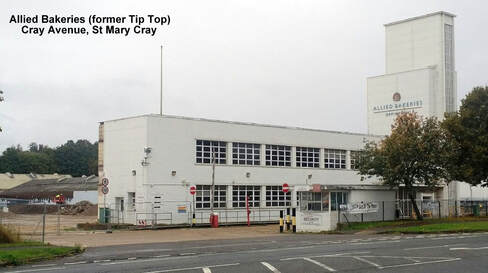
Fordcroft (1898 to 1936)
Cray Wanderers played at this ground from 1898 to 1936. The building of the A224 arterial road in 1926 sandwiched the ground between Cray Avenue and the old St Mary Cray High Street. Mr Joynson owned the Fordcroft land and after selling his paper mill in the early 1930s he decided to sell up and move away from the area. The football club had to vacate Fordcroft because the land along Cray Avenue had been earmarked by the government as an industrial enterprise zone where new factories were to be built. Tip Top Bakeries acquired the site and their building became one of the best known landmarks on the St Mary Cray skyline. As of today the building is converted into a new industrial park following closure of the bakery business in 2015.
Cray Wanderers played at this ground from 1898 to 1936. The building of the A224 arterial road in 1926 sandwiched the ground between Cray Avenue and the old St Mary Cray High Street. Mr Joynson owned the Fordcroft land and after selling his paper mill in the early 1930s he decided to sell up and move away from the area. The football club had to vacate Fordcroft because the land along Cray Avenue had been earmarked by the government as an industrial enterprise zone where new factories were to be built. Tip Top Bakeries acquired the site and their building became one of the best known landmarks on the St Mary Cray skyline. As of today the building is converted into a new industrial park following closure of the bakery business in 2015.
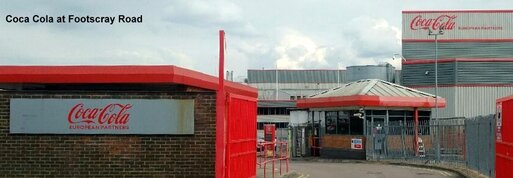
Twysdens (1936 to 1939)
This was a short-lived home for Cray Wanderers in Footscray before war put a halt to football. As of today Coca Cola Europe has expanded and modernised its distribution plant, adding more jobs to the area. Once again one of the most prominent buildings on the Cray valley skyline marks the location of a former Cray Wanderers football ground. It is a great boost for the economy of the Crays when giant commercial companies like Coca Cola want to be there. .
This was a short-lived home for Cray Wanderers in Footscray before war put a halt to football. As of today Coca Cola Europe has expanded and modernised its distribution plant, adding more jobs to the area. Once again one of the most prominent buildings on the Cray valley skyline marks the location of a former Cray Wanderers football ground. It is a great boost for the economy of the Crays when giant commercial companies like Coca Cola want to be there. .
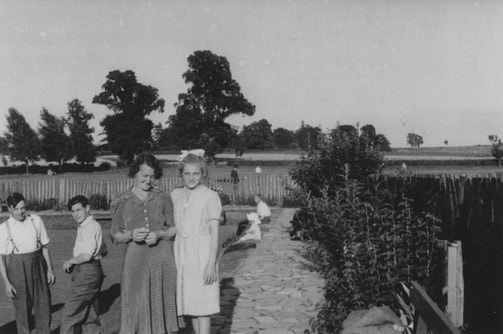
Wartime (1940s) and afterwards to Northfield Farm (1950)
During the Second World War and afterwards in the late 1940s Cray Wanderers scratched around playing where they could, and for 1942/43 operated under the name Vegpardel which was the sports club of the Vegetable Parchment MIll (successor to Joynsons). We have traced that the team used at least four different pitches. These were Grassmeade, Frognal, the Recreation Ground at Park Road and Northfield Farm.
Our photo shows the bowls green at St Mary Cray Rec in Park Road at the flat Crowhurst Way end of the park. Cray Wanderers played there in 1948 with the football pitch located at the flat end too.
During the Second World War and afterwards in the late 1940s Cray Wanderers scratched around playing where they could, and for 1942/43 operated under the name Vegpardel which was the sports club of the Vegetable Parchment MIll (successor to Joynsons). We have traced that the team used at least four different pitches. These were Grassmeade, Frognal, the Recreation Ground at Park Road and Northfield Farm.
Our photo shows the bowls green at St Mary Cray Rec in Park Road at the flat Crowhurst Way end of the park. Cray Wanderers played there in 1948 with the football pitch located at the flat end too.
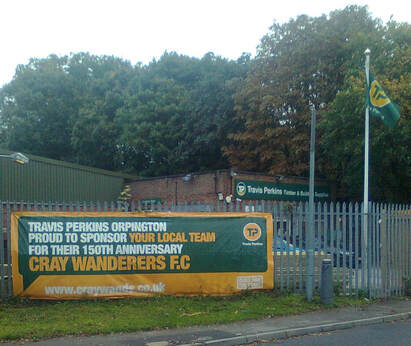
Tothills (Fordcroft) and Grassmeade (1951 to 1973)
The next period of Cray Wanderers history saw new owner Mick Slater take the club to two rented grounds in close proximity to the St Mary Cray area around Chelsfield Lane, Kent Road and St Mary Cray High Street.
Tothills (confusingly also known as Fordcroft) stood between the River Cray and the present-day Roman Catholic church, very close to the former Fordcroft ground that since 1938 was occupied by the bakery, Our photo from 2010 shows the present day Travis Perkins builders merchants whose building is close by. They kindly displayed a poster that celebrated the Wands 150th anniversary in 2010.
Moving the club to Grassmeade in 1955 Mick Slater invested much time and money to develop a fine football ground there. But in 1973 the owners St Philomenas School sold the land for building development and the Wands had to leave. The houses in Killewarren Way occupy the site today.
The next period of Cray Wanderers history saw new owner Mick Slater take the club to two rented grounds in close proximity to the St Mary Cray area around Chelsfield Lane, Kent Road and St Mary Cray High Street.
Tothills (confusingly also known as Fordcroft) stood between the River Cray and the present-day Roman Catholic church, very close to the former Fordcroft ground that since 1938 was occupied by the bakery, Our photo from 2010 shows the present day Travis Perkins builders merchants whose building is close by. They kindly displayed a poster that celebrated the Wands 150th anniversary in 2010.
Moving the club to Grassmeade in 1955 Mick Slater invested much time and money to develop a fine football ground there. But in 1973 the owners St Philomenas School sold the land for building development and the Wands had to leave. The houses in Killewarren Way occupy the site today.
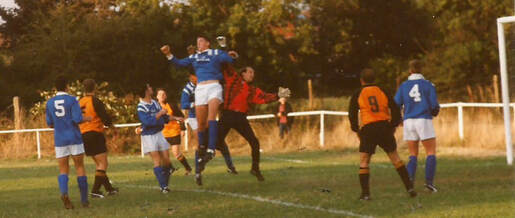
Oxford Road, Sidcup (1973 to 1997)
Moving to the outskirts of Footscray and Sidcup secured the future of Cray Wanderers. At first it was a successful period for the team on the field but it was a time when many football clubs up and down the country were experiencing a fall in attendance numbers. Land prices were rising to heights that made it difficult to acquire sites where a new ground could be built unless it was at long distance from a town centre. Gary Hillman arrived as new chairman in 1994 with Cray Wanderers desperately needing a bigger and better ground if they were to stay in senior football.
Moving to the outskirts of Footscray and Sidcup secured the future of Cray Wanderers. At first it was a successful period for the team on the field but it was a time when many football clubs up and down the country were experiencing a fall in attendance numbers. Land prices were rising to heights that made it difficult to acquire sites where a new ground could be built unless it was at long distance from a town centre. Gary Hillman arrived as new chairman in 1994 with Cray Wanderers desperately needing a bigger and better ground if they were to stay in senior football.
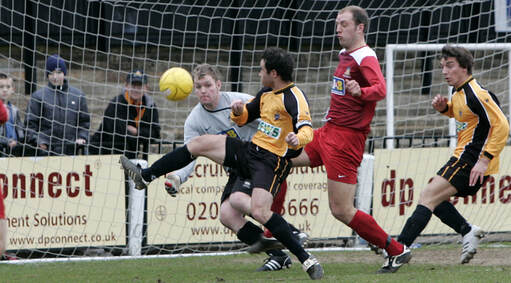
Hayes Lane, Bromley FC (1997 to present day)
Cray jumped on the bandwagon that was gradually becoming the solution of necessity for many football clubs - to share a ground with another club. Gary Hillman negotiated for Cray to become tenants of Bromley FC at Hayes Lane. It might be described in hindsight as a mixed blessing. The team prospered and progressed - rising two levels up from the Kent League to the Isthmian Premier. But to be in exile from the Crays, possessing no permanent home, was not an ideal situation for London's oldest football club. Gary Hillman embarked upon the long and winding road of looking for a suitable piece of land that the Wands could buy to build a home of their own.
Cray jumped on the bandwagon that was gradually becoming the solution of necessity for many football clubs - to share a ground with another club. Gary Hillman negotiated for Cray to become tenants of Bromley FC at Hayes Lane. It might be described in hindsight as a mixed blessing. The team prospered and progressed - rising two levels up from the Kent League to the Isthmian Premier. But to be in exile from the Crays, possessing no permanent home, was not an ideal situation for London's oldest football club. Gary Hillman embarked upon the long and winding road of looking for a suitable piece of land that the Wands could buy to build a home of their own.
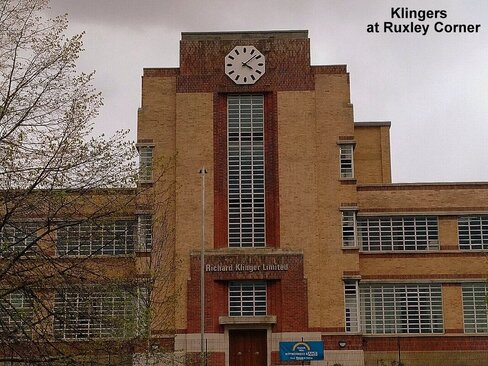
The search for a new ground in the new millennium
Our photo of the Klingers building brings us back to context of social-economic enterprise in the modern-day Crays. We have earlier blessed the redevelopment of Flamingo Park because of the aim of breathing new life into an under-used local amenity. The same applies to the Klingers site at Ruxley Corner further along the A20 Sidcup bypass. Klingers (built in 1937) was among the biggest of the many firms that made the Crays a thriving industrial area after the war. After the firm moved away and the building closed in 1990 it was left to rot. Gary Hillman identified it as a possible prospect for a new Cray Wanderers ground if Tesco were successful in acquiring the site subject to condition they would build a community sports facility there. Bromley Council didn't entertain bids by Tesco and Ikea with effect that the Klingers building fell further into disrepair. Fortunately now in 2021 work has been completed revamping the site for multiple business occupancy bringing more jobs and an uptick to the local economy.
Our photo of the Klingers building brings us back to context of social-economic enterprise in the modern-day Crays. We have earlier blessed the redevelopment of Flamingo Park because of the aim of breathing new life into an under-used local amenity. The same applies to the Klingers site at Ruxley Corner further along the A20 Sidcup bypass. Klingers (built in 1937) was among the biggest of the many firms that made the Crays a thriving industrial area after the war. After the firm moved away and the building closed in 1990 it was left to rot. Gary Hillman identified it as a possible prospect for a new Cray Wanderers ground if Tesco were successful in acquiring the site subject to condition they would build a community sports facility there. Bromley Council didn't entertain bids by Tesco and Ikea with effect that the Klingers building fell further into disrepair. Fortunately now in 2021 work has been completed revamping the site for multiple business occupancy bringing more jobs and an uptick to the local economy.
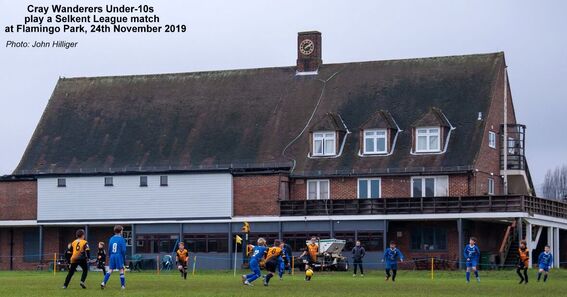
Football's Coming Home: Cray Wanderers move in at Flamingo Park
Cray Wanderers are now in the process of building and developing Flamingo Park in accordance with the planning consent to put houses there and to build football, sport and hospitality facilities all for benefit of the local community. The club is aspiring to have the football stadium ready for Isthmian League first team football to be played at Flamingo Park for the 2024/25 season starting in August. In the meantime the youth football pitches are being put to splendid use by the Cray Wanderers young boys and girls. And on 4th February 2024 the landmark first competitive match played on the new-laid 3G pitch with floodlights featured the Cray Wanderers Ladies team winning 2 - 0 versus Oakwood in the South East Counties League. How splendid it is to see the famous oldest association football club in London restored to its home area and proudly representing the big community of the Crays.
Cray Wanderers are now in the process of building and developing Flamingo Park in accordance with the planning consent to put houses there and to build football, sport and hospitality facilities all for benefit of the local community. The club is aspiring to have the football stadium ready for Isthmian League first team football to be played at Flamingo Park for the 2024/25 season starting in August. In the meantime the youth football pitches are being put to splendid use by the Cray Wanderers young boys and girls. And on 4th February 2024 the landmark first competitive match played on the new-laid 3G pitch with floodlights featured the Cray Wanderers Ladies team winning 2 - 0 versus Oakwood in the South East Counties League. How splendid it is to see the famous oldest association football club in London restored to its home area and proudly representing the big community of the Crays.
